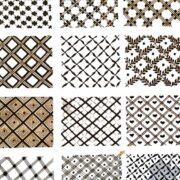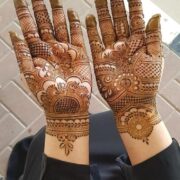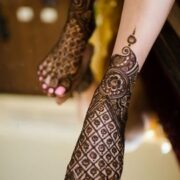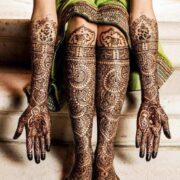Wedding Mehndi Designs Captivating: Celebrating Tradition and Elegance.
Table of Contents
Introduction:

Intricate and exquisite, mehndi holds a significant place in traditional weddings. A wedding is incomplete without the beautiful art of mehndi adorning the hands and feet of the bride. Mehndi, also known as henna, not only adds a touch of beauty to the bride’s appearance but also symbolizes auspiciousness and good luck. Let’s delve into the world of wedding mehndi designs and explore the captivating patterns that have stood the test of time.
Bridal Mehndi Designs:

Bridal mehndi designs are known for their intricacy and elaborate motifs that cover the entire hands and feet. These designs often feature traditional elements like paisleys, flowers, intricate latticework, and bride and groom figures. Intricate patterns on the palms and fingertips beautifully merge with elaborate extensions on the wrists and arms, creating a stunning visual spectacle.
Arabic Mehndi Designs:

Arabic mehndi designs are known for their bold, geometric patterns. These designs often consist of bold floral motifs, vines, and leaves. The designs are characterized by their simplicity and elegance, with open spaces that allow the henna to breathe. Arabic mehndi designs are popular among brides due to their versatility and ability to suit various wedding themes.
Indian Mehndi Designs:

Indian mehndi designs are characterized by their rich and intricate patterns, often covering the entire hand and extending up the forearms. These designs incorporate traditional Indian motifs like peacocks, elephants, lotus flowers, and intricate lace-like patterns. Indian mehndi designs are known for their opulence and are often accompanied by music and dance during the mehndi ceremony.
Moroccan Mehndi Designs:
Moroccan mehndi designs feature geometric patterns and abstract designs, inspired by Moroccan art and architecture. These designs often include elements like squares, diamonds, and triangles, arranged in intricate patterns. Moroccan mehndi designs are visually striking and add a contemporary touch to traditional wedding celebrations.
Fusion Mehndi Designs:
With the growing trend of fusion weddings, mehndi designs have also evolved to incorporate elements from various cultures. Fusion mehndi designs combine elements of different styles, such as Arabic and Indian or Moroccan and Western. These designs offer a unique and personalized touch, representing the amalgamation of cultures and traditions.
Conclusion:
Mehndi designs play a vital role in weddings, symbolizing love, beauty, and good fortune. Whether you prefer the elaborate and ornate Indian designs, the bold and elegant Arabic patterns, or the modern fusion styles, wedding mehndi designs offer a beautiful canvas for artistic expression. The intricate artistry and symbolism behind mehndi make it an integral part of weddings, connecting the bride with her cultural heritage and adding a touch of grace and elegance to her special day.
Wedding Mehndi Design
Read More
- Easy Mehndi Designs For Raksha Bandhan 2023
- Wedding Mehdni Design
- Can we apply mehendi on hands during pregnancy?
- How To Prepare Perfect Mehndi Paste
- Mother’s Day Mehndi Designs! 9 Exclusive Love Designs.
- Indian Mehndi Designs 8 Best Types Henna Design
- Burma Mehndi Design: Intricate and Exquisite Patterns for the Modern Bride
- Sharara Mehndi Dress Pakistani
- Mehndi cakes
FAQ on a Wedding Mehndi Design
How to make a Wedding Mehndi Design?
Creating a wedding Mehndi design requires practice, patience, and creativity. Here’s a step-by-step guide to help you make a wedding Mehndi design:
Total Time: 1 day
1. Prepare your materials:

a. Fresh henna paste or henna cone
b. Design templates or reference images
c. Plastic squeeze bottle or cone for applying henna
d. Tissues or cotton balls
e. Lemon juice and sugar mixture (optional)
f. Essential oils (such as eucalyptus or lavender) for aftercare (optional)
g. Gloves (to protect your hands from staining, if desired)
2. Clean and prepare the skin:

Ensure that the hands and feet are clean and free of any oils, lotions, or dirt.
If desired, you can lightly exfoliate the skin to remove dead cells and promote better henna adhesion.
3. Create a design plan:
Decide on the style and elements you want to incorporate into your design. Look for inspiration in traditional Mehndi designs, bridal magazines, or online resources.
You can choose to include paisleys, floral patterns, intricate motifs, geometric shapes, peacocks, or any other symbols or elements that hold significance for you.
4. Start with a basic outline:
Begin by creating a basic outline of the design using a thin line of henna. This will act as a guide for the rest of the design.
You can start from the fingertips and work your way up to the forearm or create a design that covers the entire palm.
5. Fill in the design:
Once the outline is in place, start filling in the design with henna paste. Use gentle pressure to create lines and shapes.
Experiment with different patterns, such as swirls, dots, or shading, to add depth and intricacy to the design.
Consider alternating thick and thin lines, creating symmetrical patterns, or incorporating negative space for an interesting composition.
Take breaks and let the henna dry:
Allow the henna to dry naturally for at least a couple of hours or until it forms a hard crust on the skin. This helps the henna adhere to the skin and develop a rich color.
Lemon-sugar sealant (optional):
If desired, you can apply a mixture of lemon juice and sugar over the dried henna design using a cotton ball. This helps in enhancing the color and longevity of the design.
Keep the henna on for an extended period:
For the darkest and long-lasting color, keep the henna on for a minimum of 4-6 hours or overnight if possible. You can wrap the design with tissue or plastic wrap to protect it while it sets.
Scrape off the dried henna:
Gently scrape off the dried henna using a tissue or your fingers. Avoid using water at this stage.
Aftercare:
Apply a thin layer of natural oil, such as coconut oil or olive oil, on the dried Mehndi to moisturize and protect the design.
Avoid excessive water exposure, heat, and friction to prolong the life of the design.
Optionally, you can also use essential oils mixed with water to lightly dab over the Mehndi design for added shine and fragrance.
Remember, practice makes perfect, so don’t be discouraged if your initial designs aren’t as intricate as you’d like. With time and practice, you’ll be able to create beautiful and elaborate wedding Mehndi designs.
What is a wedding Mehndi design?
Wedding Mehndi design refers to the intricate and decorative patterns created on the hands and feet of the bride and sometimes the groom as part of traditional Indian, Pakistani, and Middle Eastern wedding celebrations. Mehndi, also known as henna, is a temporary dye derived from the leaves of the henna plant. The application of Mehndi is considered auspicious and is an integral part of wedding rituals and festivities in many cultures.
What are some popular wedding Mehndi designs?
There are various popular Mehndi designs that are commonly seen at weddings. Here are a few examples:
Traditional Indian/Marwari design: This design typically features intricate patterns covering the entire hand and extending up to the forearm. It often includes paisley motifs, floral patterns, peacocks, and other traditional elements.
Arabic design: Arabic Mehndi designs are known for their bold and flowing patterns. They often include large floral motifs, vines, and geometric shapes. The fingertips are usually covered with henna as well.
Pakistani design: Pakistani Mehndi designs are a blend of Indian and Arabic styles. They are characterized by intricate detailing, delicate patterns, and the use of both geometric and floral elements.
Moroccan design: Moroccan Mehndi designs often feature geometric patterns, diamonds, and zigzag lines. They tend to have a bold and abstract look.
Indo-Arabic fusion design: This design combines the elements of Indian and Arabic Mehndi styles. It incorporates intricate patterns with bold outlines, elaborate shading, and a mix of floral and geometric motifs.
How soon before the wedding should I get my Mehndi done?
It is generally recommended to get your Mehndi done one to two days before the wedding. This allows the henna to dry and develop its rich color before the wedding day. It also gives you time to relax and ensure that the Mehndi doesn’t smudge or get damaged while you perform other wedding-related activities.
Q: How can I find a Mehndi artist for my wedding?
Here are a few ways to find a Mehndi artist for your wedding:
Ask for recommendations: Seek recommendations from friends, family, or acquaintances who have recently had a Mehndi done for their wedding. They can provide you with references based on their personal experience.
Online platforms: Utilize online platforms such as wedding directories, social media platforms, and online marketplaces where Mehndi artists showcase their work. You can browse through portfolios, read reviews, and contact artists directly.
Bridal exhibitions and fairs: Attend bridal exhibitions or fairs where you can find multiple Mehndi artists and have the opportunity to see their work in person.
Local beauty salons and parlors: Inquire at local beauty salons and parlors if they provide Mehndi services or if they can recommend a skilled artist.
When selecting a Mehndi artist, it’s important to review their portfolio, check their experience and expertise, discuss your design preferences, and inquire about their pricing and availability.
How long does a wedding Mehndi design last?
The longevity of a Mehndi design depends on various factors such as the quality of the henna, the skill of the artist, and how well the henna is taken care of after application. Typically, a wedding Mehndi design can last anywhere from a few days to a couple of weeks. The color of the Mehndi is darkest on the first day and gradually fades over time.
Q: How can I take care of my Mehndi design to make it last longer?
To make your Mehndi design last longer, here are some tips for care and maintenance:
Avoid water contact: Keep your hands and feet away from water for at least 6-8 hours after the Mehndi application. This allows the henna to dry and adhere to the skin properly. Also, avoid activities that may cause excessive sweating or make the design wet.
Lemon-sugar sealant: Once the Mehndi is completely dry, you can apply a mixture of lemon juice and sugar on the design using a cotton ball. This sealant helps in enhancing the color and longevity of the design. Let it dry and leave it overnight if possible.
Avoid scraping or scratching: Refrain from scratching or scraping the Mehndi design, as it can cause the henna to flake off prematurely. Gently pat the design if it itches.
Heat exposure: Excessive heat can fade the Mehndi color quickly. Avoid direct contact with heat sources such as hot water, sunlight, and heating appliances.
Oil application: Applying a thin layer of natural oil, such as coconut oil or olive oil, on the dried Mehndi can help keep it moisturized and prevent it from cracking or peeling off too soon.
Avoid exfoliating products: Avoid using exfoliating scrubs or harsh soaps on the Mehndi area, as they can cause the design to fade quickly.
Protect the design while sleeping: To prevent smudging or smearing the design while sleeping, consider wearing loose-fitting clothing and avoid direct contact of the Mehndi with bedding.
Remember that Mehndi designs naturally fade over time, so it’s important to take care of them to ensure they last as long as possible.





















Pingback: Easy Mehndi Designs For Raksha Bandhan 2023 - Mehndi Designs
Pingback: Can we apply mehendi on hands during pregnancy? 2 Best Hacks. - Mehndi Designs
Pingback: BTC Silk and Shine 19 Hair Products: Unveiling the Secret to Lustrous Locks" - Job News Alerts